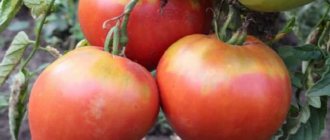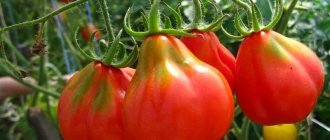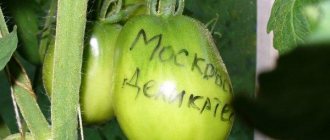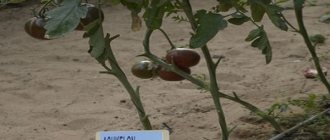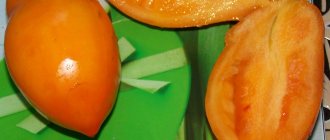Tomatoes are a heat-loving crop native to South America. In most of our country, conditions for its cultivation are far from ideal. Constant temperature changes, cold rains and winds are negative factors present in most regions of Russia. Therefore, domestic gardeners grow many varieties of tomatoes in greenhouses.
Thanks to selective breeding, agronomists have been able to develop tomatoes with increased hardiness. They are not afraid of temperature changes and are undemanding to care. These varieties include the early ripening tomato Zhenechka.
General description of the variety
Tomato Zhenechka is a variety bred by domestic breeders . It appeared on gardening markets quite a long time ago, but has not yet lost its popularity. The variety is sold in most gardening stores.
Distinctive features of Zhenechka tomatoes
The main feature of the Zhenechka variety is its exceptional endurance . Plants are resistant to cold weather and temperature changes. They are suitable for growing in open ground in the middle zone and northern regions.
This tomato belongs to the ultra-early varieties . Its berries ripen 85-90 days after emergence.
Zhenechka's fruits are not particularly refined . They are medium in size and have the usual tomato sweet and sour taste. Tomatoes are red in color.
The Zhenechka variety is gastronomically universal . It is consumed fresh, canned whole and processed into juices. They are not suitable for freezing and drying.
Tomato is immune to most diseases . Its resistance is lower than that of some modern hybrids. Therefore, he needs additional preventive treatment against diseases.
The peculiarity of the variety lies in the ease of its cultivation . Due to the low growth of the bush, it does not need pinching. Many gardeners don’t even form it.
Main characteristics
The description of the Zhenechka variety will please even experienced gardeners . This tomato is able to grow even in extreme conditions. It was bred for planting in regions with temperate and northern climates.
Characteristics of tomatoes Zhenechka:
| Parameter | Indicators |
| Bush type | Determinate tomato. The height of the bush does not exceed half a meter. The stems are thick and powerful. The bushes are covered with an average amount of greenery. The leaves are medium sized, rich green. The inflorescences are simple. The first is formed after 5-6 leaves. The next ones after 1-2 sheets. The bush is spreading and branched, which is what ensures high yields for dwarf plants. Fruits are formed in clusters of 5 pieces. in each. |
| Growing method | Cold-resistant. Manufacturers recommend growing it in open ground even in regions with cold and temperate climates. Cultivation in greenhouses and on balconies is possible. |
| Productivity | Good for early ripening tomatoes. From one bush you get from 2.5 to 4 kg of berries. For 1 sq. m plant from 6 to 8 bushes. The fruits ripen almost simultaneously. Fruiting continues until August. |
| Fruit | Average. Weight varies from 80 to 100 g. The maximum recorded weight does not exceed 150 g. The fruits are red inside and out. Tomatoes have a round shape, without a flattened base. The berries are fleshy but juicy. The pulp is crumbly. The taste is characteristic of tomatoes – sweet with a slight sourness. One fruit has 4-5 chambers with seeds surrounded by a jelly-like liquid. |
| Transportability | High. The fruits have a tough skin. Thanks to this, they are stored for a long time and are suitable for transportation over long distances. |
| Ripening time | Ultra early ripening. The first harvest ripens 80 days after sowing the seeds. |
| Disease resistance | Is immune to many tomato diseases. There is a risk of fungal infection. |
The main purpose of the variety and its stability
Tomato varieties are best suited for salads, stewing, baking and canning; fresh consumption is also possible.
The variety has high resistance to diseases and unfavorable conditions. The Zhenechka tomato is an early-ripening variety; the main harvest occurs at the end of June, so it is not afraid of the August cold period, and therefore late blight will bypass.
The Siberian variety was bred specifically for productive cultivation in the Ural and Siberian regions and is resistant to weather changes. If there is a risk of infection with fungal diseases, plants are treated with a solution of phytosporin, diluted according to the instructions.
Growing seedlings
Zhenya's seedlings are planted two months before the plants are planted in a permanent place . It is important not to overexpose plants in pots. Otherwise, ovaries will quickly form, and the tomatoes will not be able to be replanted.
When do they start growing seedlings in different parts of Russia?:
- in the southern regions, Zhenechka seeds are sown in early March;
- in the northern zone - in early April;
- in cities with a temperate climate - at the end of March.
Note ! In the warm cities of our country, it is possible to grow tomatoes without seedlings. In this case, fruit ripening will occur much later.
Seed treatment
Proper seed treatment will increase their germination and prevent plant infection. Therefore, this stage is considered important.
First of all, you need to check the seeds for germination in salt water . To do this, add 1 teaspoon of salt to a glass of warm liquid. After half an hour, the floating planting material is removed, and the planting material that has sunk to the bottom is washed and dried.
To disinfect, seeds are immersed in a weak solution of potassium permanganate . It is prepared from a glass of water and 3 g of potassium permanganate. The seeds are soaked in this product for half an hour. After this, they are washed with running water. Other means are also used for treating planting material: soda solution, aloe juice and Fitosporin.
To speed up seed germination, they are treated with a growth stimulant . Usually "Epin" or honey solution is used.
Preparing soil and containers
The Zhenechka variety is inexpensive and not uncommon . Therefore, few gardeners decide to plant them in peat tablets. Seedlings are grown in the usual way.
Wide containers are used to germinate seeds . They don't have to be deep. Plastic trays and wooden boxes, both purchased and homemade, are suitable.
Plants are planted in individual pots . Peat and plastic pots are sold in stores. They are made independently from disposable tableware, bottles and juice boxes. The capacity of such containers should not be less than 300 g.
Containers need to be disinfected . To do this, they are soaked for 30 minutes in a strong solution of potassium permanganate.
To grow tomato seedlings, use light but nutritious soil . You can purchase it ready-made in a special store or prepare it yourself.
To prepare the earthen mixture, peat, humus and black soil are taken in equal proportions . Sand or sawdust is added to the composition. To make the soil more noble, ash and superphosphate are mixed into it. The finished soil mixture is disinfected. To do this, the soil is calcined in the oven at a temperature of 100 degrees or watered with copper sulfate.
Sowing seeds
A layer of earth is poured into the container so that there is 3 cm of free space left to the edge . The seeds are laid out on the soil in rows. There should be a gap of at least 2 cm between the rows, and at least 1.5 cm between the seeds. The seeds are sprinkled with a centimeter layer of soil without compacting. The soil is moistened with warm water from a spray bottle.
The container is covered with film and placed in a warm place . The rate of seed germination depends on how warm the room is.
Planting and care
Sowing begins in the second week of March. Seeds are disinfected by immersing them in a weak solution of potassium permanganate for 20 minutes. After washing with water, the grains are placed in a solution of a growth stimulator for 6 hours, after which they are laid out in prepared containers with moist soil. Germination lasts 5-8 days.
Before planting, the plants are hardened off: this will help them quickly adapt to normal climatic conditions. Planted in May.
Care consists of timely watering, loosening, and weeding. After the plant forms the first cluster, the lower leaves are removed. The variety is unpretentious; there is no need to build a greenhouse for it.
Agricultural technology of tomatoes Zhenechka
Zhenechka tomatoes are planted in a permanent place when the soil warms up enough .
This variety can withstand temperature drops of up to 10 degrees. The time for planting tomatoes in open ground depends on the region :
- southern - in April;
- with a temperate climate - in May;
- northern - in early June.
Three days before picking, the seedlings are prepared . It is watered abundantly and fed with fertilizers containing potassium and phosphorus.
Planting plants in a permanent place
For tomatoes, choose the sunniest place in the garden. This will increase the number of fruits and improve their taste. In the fall, the beds are prepared. They are dug up and cleared of plant debris. The soil is fertilized with manure or humus. To reduce the acidity of the soil, add dry lime. In the spring, the area of the garden intended for growing tomatoes is dug up again. All formed roots are removed.
Holes for planting tomatoes are dug in rows in a checkerboard pattern . For Zhenechka, a rapid landing is acceptable. For 1 sq. m place 6-8 holes. Handfuls of ash are poured into the holes. Some gardeners also add long-acting granular mineral fertilizers there. Before planting, the tomatoes are removed from the pots along with a layer of soil, after which they are placed in the holes, carefully laying the root system. Asthenia is buried so that no more than 7 leaves remain on each bush.
After planting, water is poured into the holes . After this, they are covered with earth, which is not compacted.
Note! Tomatoes should not be planted at the height of the heat. This procedure is carried out on cloudy days or at sunset.
Planting tomato seedlings in open ground
Tomato care
Tomato Zhenechka does not need shaping . The high performance of this dwarf variety is ensured by the spreading nature of its bush.
Plants are planted only up to the first ovary . Not only the stepsons are removed, but also the lower leaves.
Despite the short growth of the plants, they need a garter . Otherwise, during the fruiting period, the tomato stems will break and the berries will end up on the ground.
Water tomatoes not often, but generously . The hotter the summer, the more often watering is performed.
Fertilize the Zhenechka tomato at the root 3 times per season. Alternate complex and organic fertilizers. If long-acting mineral granules were added during planting, then the tomatoes are fertilized with complex compounds only for the last time.
Foliar fertilizing is applied twice a season . For this purpose boron fertilizers are used.
Note! Gardeners argue about whether it is necessary to hill up tomatoes. This procedure is not necessary, but if additional roots appear on the stem of the plant, then they must be covered with soil.
Common Mistakes
If Zhenechka’s tomatoes are sick or have low yields, then most likely the gardener made mistakes when growing them. Below are the most common ones :
- Working with tomatoes in the middle of the day . Plants are already stressed in the heat. Therefore, planting them and watering them during the day will increase the risk of burns and the development of diseases. These procedures are carried out in the early morning or evening.
- Watering plants with cold water . In this case, there is a high risk of the tomato roots getting cold, which will lead to their withering and death. To water the plants, use settled water at room temperature.
- Spraying the ground parts of plants with water . This mistake will lead to diseases of the tomatoes and the appearance of pests on their bushes. Tomatoes are watered only at the root.
- Refusal to loosen . After each moistening of the soil, an earthen crust forms on it. It interferes with air exchange and slows down the evaporation of moisture, which often leads to the death of roots. To prevent this from happening, the beds with tomatoes are loosened after each watering and rain.
- Planting plants in one place for more than 3 years . This increases the risk of plant infection and makes the soil poor. You cannot plant tomatoes in beds where other nightshade crops were grown. These plants do not do well when next to potatoes.
Diseases and pests
Zhenechka is a variety that is resistant to tomato diseases . Due to its early ripeness, it does not suffer from late blight. Immunity will protect plants from diseases only with proper prevention. It consists of treating all objects that come into contact with plants and the seeds themselves with disinfecting compounds.
It is equally important to follow the rules of tomato agricultural technology . You also need to make sure that the fruits do not lie on the ground.
To prevent insect attacks that damage fruits, leaves and roots of plants, tomatoes are sprayed with a solution of celandine. A soap solution will help deal with aphids. Tomatoes are protected from root pests even at the planting stage. To do this, cut plastic bottles are placed around the roots of the plants or the beds are sprinkled with egg shells. Large pests are collected by hand. This should be done at least once a week.
About other varieties of tomatoes:
Ultra-early, non-capricious, low-growing and very tasty “Boni MM”
A variety with an appetizing name - “Strawberry” tomato
Transfer rules
The optimal time for transplanting tomatoes into the garden is mid or late May. By this time, the threat of return frosts will have passed, it will become warmer outside and the soil will warm up to a temperature of 10-12°C. Typically, seedlings are transplanted at the age of 55-60 days.
Before this, the tomatoes undergo a 10-day hardening process. They are taken out into the fresh air every day and kept for several hours. During the last 24 hours they are left to spend the night outside under cover.
Preparing the site
This is a sun-loving crop, so it needs to be planted in a sunny and wind-protected area, where there is no swamp. The soil should be low in alkalinity and acidity.
The beds are prepared in the fall:
- choose a place where the best predecessors of tomatoes previously grew - cucumbers, legumes, cabbage or beets;
- cleared of weeds and vegetation residues;
- sprinkle with a nutrient composition - 10 kg of humus (compost), 3 kg of wood ash, 100 g of superphosphate and 80 g of potassium sulfate per 1 m²;
- carry out deep digging without breaking up lumps.
If the soil is acidified, you need to add an additional 300 g of chalk, dolomite flour or slaked lime.
In the spring, 2 weeks before the planned planting of seedlings, the bed is treated with a solution of Fitosporin. It helps to destroy all pathogenic bacteria and improve the nutritional value of the soil.
Planting scheme
This is a low-growing and compact variety, so the optimal planting pattern will be 40x50 cm. Dug holes according to the size of the root system of the seedlings, spill 1 liter of water. After absorbing moisture, the roots are lowered, sprinkled with earth, lightly compacted and hilled.
Features of cultivating tomatoes in open and protected ground
The Zhenechka tomato variety is rarely grown in a greenhouse . If it is planted in protected soil, it is important to maintain an optimal humidity level, which should not exceed 60%. To do this, ventilate the room daily.
In open ground, during the first two weeks after planting, plants are covered with film in the evening, protecting them from night frosts. If the temperature outside drops below 10 degrees, then this is done during the day.
Mulching beds in open ground is mandatory . This will protect the plants from frost, diseases and harmful insects.
Features of cultivation and storage
To obtain an early harvest, tomatoes are transplanted into prepared shelters. A tunnel made of covering material saves you from night frosts in May; even cold-resistant varieties of tomatoes cannot tolerate temperatures close to 0 ° C or negative temperatures.
The bed for tomatoes is chosen taking into account crop rotation. The optimal predecessors would be beets, peas or cucumbers.
Despite its early ripeness, the variety is perfectly stored. For large volumes of harvested crops, some are placed in a cellar equipped with ventilation. Tomatoes are placed in wooden boxes, sometimes sorted, removing overripe or rotten specimens.
Advantages and disadvantages of Zhenechka
Advantages of the Zhenechka variety:
- early ripeness;
- immunity to tomato diseases;
- high transportability;
- good yield indicators;
- ease of care;
- cold resistance;
- the possibility of growing in open ground in all regions of the country;
- no need for formation;
- pleasant taste;
- gastronomic versatility.
No disadvantages have been identified in this variety . These are great classic tomatoes.
Pests and diseases
Early tomatoes have a great advantage over other varieties, since their fruiting ends by the time the August fogs and cold snaps arrive.
Since the variety was bred specifically for areas with risky farming, it is characterized by resistance to temperature changes and unpretentiousness.
For prevention, if there is a risk of disease, plants are treated with phytosporin and copper-containing preparations.
The most dangerous pests of tomatoes are Colorado potato beetles, wireworms, beetles (chafer beetle larvae), as well as whiteflies and slugs.
To repel the Colorado potato beetle from plantings, use birch tar diluted in liquid laundry soap. The composition is sprayed onto the soil around the plants.
Colorado beetles are collected by hand, avoiding the hatching of larvae, which can leave the plant without leaves.
Farmer reviews
All reviews from farmers who have tried the Zhenechka tomato are positive . And despite the large number of unusual and sweeter varieties, this tomato is still popular.
Irina Teterina, Tagil : “I have been planting Zhenechka on my plot for several years now. Tomatoes that are ordinary in taste and size and make you remember your childhood. The advantages of this variety lie in its unpretentiousness. He is not afraid of cold weather, does not need grooming and is absolutely not capricious. In addition, Zhenya will ripen earlier than other tomatoes. Good both fresh and canned. If you want a variety that won’t surprise you in any way, but definitely won’t let you down, then Zhenechka is your option.”
Vitaly Lisitsyn, Belgorod : “I grow tomatoes at the dacha. The easiest variety to care for. I visit the dacha once every 1-2 weeks, and this is enough to get an excellent harvest. The tomatoes are round, just like in the photo.”
Mistakes of summer residents
Growing this crop requires some knowledge and skills, so beginners are not always able to get a tasty and abundant harvest in the first year of planting. This happens for several reasons:
- using expired or infected seed that does not germinate well and produces diseased seedlings;
- sowing in too small a container, as a result, the seedlings suffer from a lack of nutritional components and space for root development - they turn yellow and wither;
- lack (or excess) of light or moisture, which also negatively affects the development of young shoots;
- transplantation without accustoming to sunlight and fresh air - such sprouts usually quickly wither from freezing or turn yellow from overheating in the sun;
- lack of basic care - watering, fertilizing, preventive treatments, loosening and weeding;
- tomatoes growing in weed thickets will produce a meager harvest and begin to get sick.
